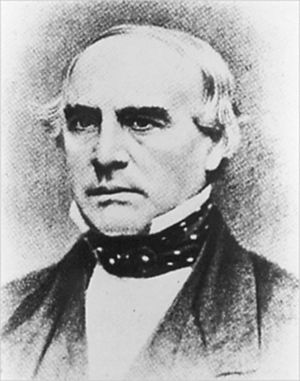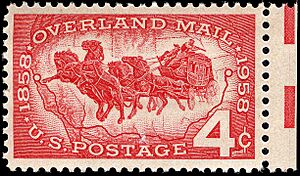John Butterfield (businessman) facts for kids
Quick facts for kids
John Butterfield
|
|
|---|---|
 |
|
| Born | November 18, 1801 Berne, New York, U.S.
|
| Died | November 14, 1869 (aged 67) Utica, New York, U.S.
|
| Resting place | Forest Hill Cemetery Utica, New York, U.S. |
John Butterfield (born November 18, 1801 – died November 14, 1869) was a very important person in transportation during the mid-1800s. He helped connect different parts of America. He started many companies, including American Express, which is still a big company today.
One of his most famous projects was the Butterfield Overland Mail Company. This was the longest stagecoach line in the world! It ran from 1858 to 1861. This stagecoach line helped connect the new state of California with the rest of the United States.
Contents
Early Life and Beginnings
John Butterfield was born on November 18, 1801, in Berne, New York. His family had come to America from England a long time ago, in 1638. John went to school near his home, but he didn't get much formal education. He started working in the stagecoach business when he was quite young.
Building a Business Empire
John Butterfield began his own stagecoach lines in his hometown of Utica, New York. He quickly made his transportation business much bigger.
He soon realized that people needed a way to send packages and important documents. This led him to create "express" services using his stagecoaches and other transport.
Forming American Express
Other business people in New York also started their own express companies. They used John Butterfield's large transportation network. Henry Wells and William Fargo were two of these people. Their companies, Wells & Co. and Livingston, Fargo & Co., became competitors to Butterfield's company.
John Butterfield saw that it would be better if these companies worked together. So, in 1850, the three companies joined to form The American Express Company. It had two main parts. One part, called Wells, Butterfield & Co., handled express business from Buffalo, New York, to the east. The other part, Livingston, Fargo & Co., managed express business from Buffalo to St. Louis, Missouri.
The Famous Overland Mail Company
John Butterfield's Overland Mail Company was a huge project. It cost about $3.5 million to build and keep running. This was a lot of money back then! Some of the money came from banks and other express companies.
The Butterfield Trail was so important that in 2009, the U.S. government started a study to make it a National Historic Trail. This means it's a special place that tells an important part of American history.
Overland Mail and Wells Fargo
Some people have wondered if Wells, Fargo & Co. owned part of Butterfield's Overland Mail Company. However, the official six-year contract for the Overland Mail Company does not show Wells, Fargo & Co. as an owner. Wells, Fargo & Co. did not get into the stagecoach business until 1867. This was five years after Butterfield's company stopped running on the Southern Overland Trail.
John Butterfield's Legacy
John Butterfield's son, Daniel Adams Butterfield, became a Union general during the American Civil War. He also worked for the U.S. Treasury. Daniel is famous for creating the bugle call Taps in 1862. This is the sad and beautiful music played at military funerals.
John Butterfield passed away on November 14, 1869, at his home in Utica, New York. He was buried in Forest Hill Cemetery in Utica. This was the same city where he started his very first stagecoach line.
See also


